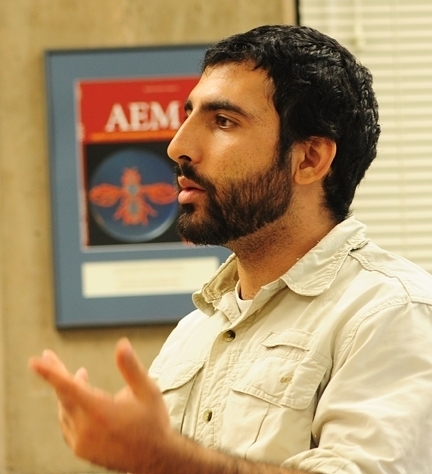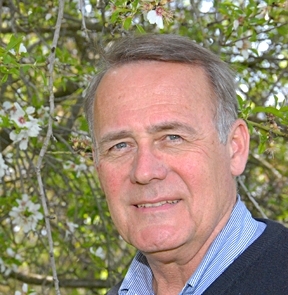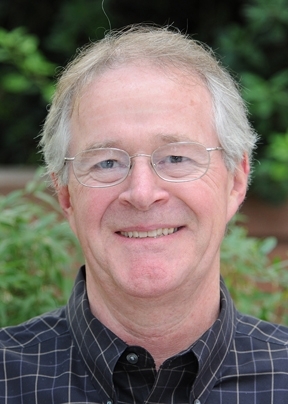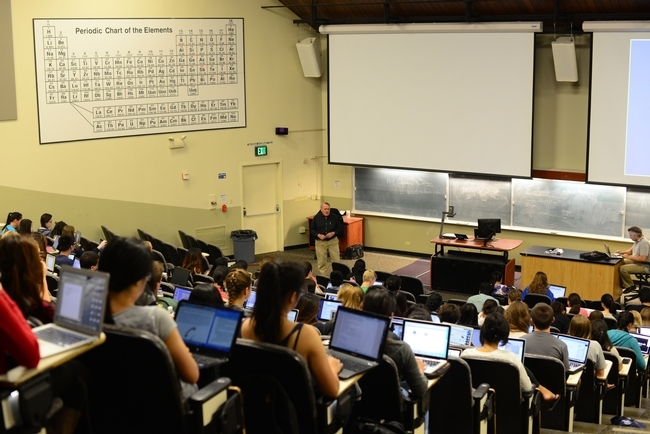
The Pacific Branch of the Entomological Society of America (PBESA) has announced that two distinguished professors and a graduate student from the Department of Entomology and Nematology, University of California, Davis, have won major awards.
Distinguished Professors James R. Carey and Thomas W. Scott, and doctoral candidate Mohammad-Amir Aghaee will be among those honored at PBESA's 99th annual meeting of PBESA, set April 12-15 in Coeur d'Alene, Idaho. PBESA encompasses 11 Western U.S. states, plus several U.S. territories and parts of Canada and Mexico
Carey won the Distinguished Teaching Award and his nomination packet will now advance to the national level. Scott won the C. W. Woodworth Award, the highest honor given by PBESA. Aghaee won the John Henry Comstock Graduate Student Award, the highest graduate student award given by PBESA.
Of note: Scott is the 10th UC Davis-affiliated entomologist to win the Woodworth award. This is the third consecutive year that UC Davis has won the Comstock award (previous recipients were Kelly Hamby and Matan Shelomi) and this is the second consecutive year that UC Davis has won the teaching award (Diane Ullman received the 2014 award and then went on to win the national award).

Carey last year received the 2014 Distinguished Teaching Award from the UC Davis Academic Senate, an honor given to internationally recognized professors who excel at teaching. PBESA singled him out for his technological innovations, creativity and excellence.
“Dr. Carey is not only considered the most technologically innovative and creative classroom teacher on the UC Davis campus, but his expertise is highly regarded throughout the UC statewide system,” wrote nominator Michael Parrella, professor and chair of the UC Davis Department of Entomology and Nematology. “He crafted a groundbreaking model for 21st century instruction, and his presentations are in high demand statewide, nationally and globally. His presentations have taken him from UC Davis to UC Irvine to the University of Alabama, and beyond, including Germany, Korea, Denmark, France and Africa.”
“Dr. Carey uses synergistic strategies to develop video-based learning methods for faculty research programs, professional networks and outreach programs,” Parrella said. “He has developed ‘what-you-need-to-know' videos to increase writing and speaking skills and technical fluency, as well as to understand such subjects as copyright and fair use laws. All are geared for ease of learning and increased knowledge retention.”
Carey last year received the 2014 Distinguished Teaching Award from the UC Davis Academic Senate, an honor given to internationally recognized professors who excel at teaching.
When asked his philosophy of teaching, Carey said: “My philosophy of teaching is inseparable from my philosophy of scholarship. Students need to know the big picture to understand the pixels. They need to zoom in and zoom out so that they can consider the details I present in class in the context of larger conceptual and operational frameworks.” (See more.)

Scott, a noted medical entomologist, is a global authority on dengue and other mosquito-borne diseases. In accepting the award, he will present a 30-minute talk April 13 on “Embracing Complexity: The Path to Improved Public Health Entomology.”
Scott, who has researched mosquito-borne disease for 35 years, is a global authority on the epidemiology of mosquito-borne disease, mosquito ecology, evolution of mosquito-virus interactions, and evaluation of novel products and strategies for mosquito control and disease prevention. Among the top vector biologists in the world, he is recognized as the leading expert in the ecology and epidemiology of dengue, said nominator Michael Parrella, professor and chair of the UC Davis Department of Entomology and Nematology.
Scott is known for his holistic and comprehensive approach in finding solutions to protect the world's population from dengue, a disease that infects some 400 million per year. Some 4 billion people in 128 countries, more than half of the world's population, are at risk for dengue. Currently no vaccine or drug is effective against this life-threatening disease.
Scott's most significant research contributions concern the ecology and epidemiology of dengue:
- Blood feeding behavior, longevity, dispersal, and vector-virus interactions of the mosquito Aedes aegypti;
- Longitudinal cohort studies of spatial and temporal patterns in human dengue virus infection in Peru and Thailand; (dengue research in Peru, Thailand, Puerto Rico and Mexico for the past 25 years)
- Impact of human movement on mosquito contact rates and spatial dimensions of dengue virus transmission; and mathematical and computer simulation modeling of mosquito population biology and mosquito-borne pathogen transmission. (See more.)
Mohammad-Amir Aghaee
Mohammad-Amir Aghaee, a doctoral candidate and researcher in the Larry Godfrey lab, is a fifth year Ph.D. candidate working on rice water weevil management in California rice. He will present a talk on the rice water weevil, Lissorhoptrus oryzophilus. He will be among the six Comstock recipients, all winners from their individual branches, honored at the national ESA meeting, Nov. 15-18, 2015 in Minneapolis, Minn.
“Mohammad took on a very difficult project for his dissertation research,” said Extension entomologist Larry Godfrey, who nominated Aghaee for the award. “His project deals with the most important invertebrate pest of rice in California, the rice water weevil. The challenges arose not only from working in the rice system--wading through mud for hours--but also from working with this insect that cannot be reared in the laboratory and which has one generation per year. Therefore, all the field studies had to be conducted within the short window of time each year.”
“Mohammad took on a very difficult project for his dissertation research,” said Extension entomologist Larry Godfrey, who nominated Aghaee for the award. “His project deals with the most important invertebrate pest of rice in California, the rice water weevil. The challenges arose not only from working in the rice system--wading through mud for hours--but also from working with this insect that cannot be reared in the laboratory and which has one generation per year. Therefore, all the field studies had to be conducted within the short window of time each year.”
Active in ESA, Aghaee captained the UC Davis debate team that won the ESA championship in 2013 and 2014. He anchored the UC Davis debate and Linnean Games teams for four years, from 2011 to 2014. He served on the UC Davis Linnaean Team (the Linnaean Games involve answering entomological questions) that won the PBESA championship in 2012. For four years, Aghaee has participated in the ESA's student 10-minute paper competitions, covering such topics as Lygus bug movements in bush beans, efficacy of Bacillus thuringiensis spp. galleriae against rice water weevil, and preliminary research on winter flooding effectiveness against rice water weevil. He won a first-place President's Award for his winter flood presentation in 2013.
Aghaee received his bachelor's degree in environmental sciences, genetics and plant biology in 2010 from UC Berkeley, with high distinction. He obtained his master's degree in entomology from UC Davis in 2012, and expects to receive his doctorate in December 2015
In his research, Aghaee seeks to develop alternative management options for rice growers as part of his dissertation. “I have examined the use of Bacillus thuringiensis spp. galleriae as a biopesticide for rice water weevil and explored the mechanisms of winter flooding rice fields as a cultural control against weevil larvae. I am currently examining the possible role of silicon augmentation as a means of increasing rice tolerance to weevil damage and the potential threat of Brown marmorated stinkbug (Halyomorpha halys) to California rice.
Aghaee and Godfrey recently published an open-access article appearing in the Journal of Integrated Pest Management that discusses the rice water weevil's life history and invasion biology, as well as management strategies and future directions of research. They told the story of the weevil since it was first identified as a pest in 1881 by C. V. Riley and L. O. Howard. They then discussed reasons why it has been able to spread so rapidly — up to 36 kilometers per year in some cases — which is partly because of its ability to reproduce asexually.
“This invasive ability is aided by a particular and peculiar aspect of this weevil's biology, the fact that a small percentage of the population in its native range reproduces by parthenogenesis,” they wrote.
The most harmful insect pest of rice in the United States, it causes yield losses of up to 25 percent. Adults inflict damage by consuming leaf tissue, and the larvae feed on the roots of rice plants. A native of the southeastern U.S., the rice water weevil invaded Japan in 1976, Korea in 1980, China in 1988, and Italy in 2004. (See more.)
Congratulations to Professors Carey and Scott and doctoral student Mohammad-Amir Aghaee! It's quite an honor to receive these awards. PBESA encompasses 11 U.S. states (Alaska, Arizona, California, Hawaii, Idaho, Montana, Nevada, Oregon, Utah, Washington and Wyoming); several U.S. territories, including American Samoa, Guam and the Northern Mariana Islands; and parts of Canada and Mexico.
Attached Images:
